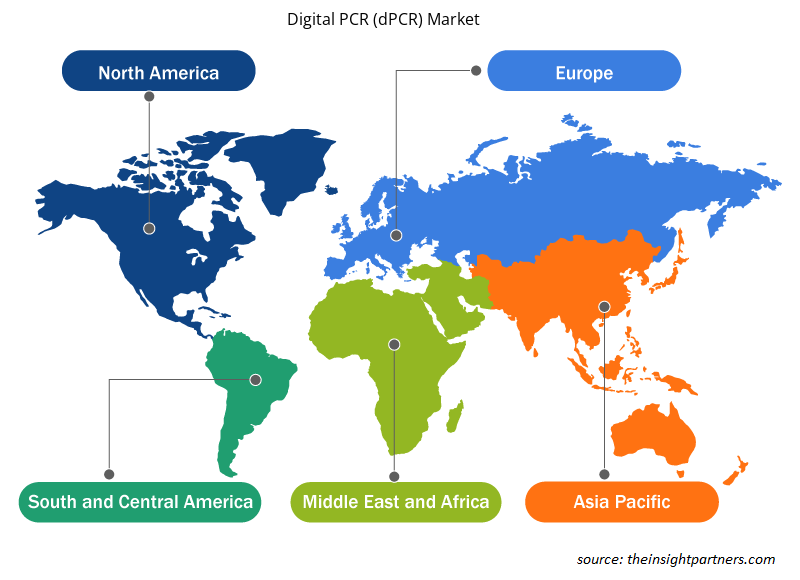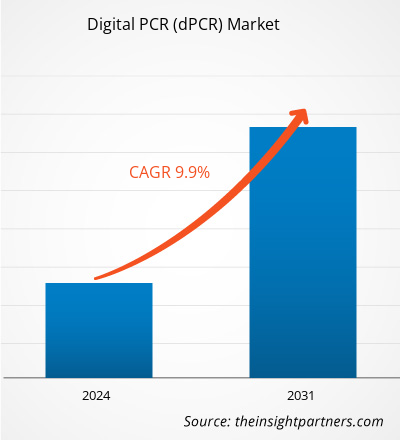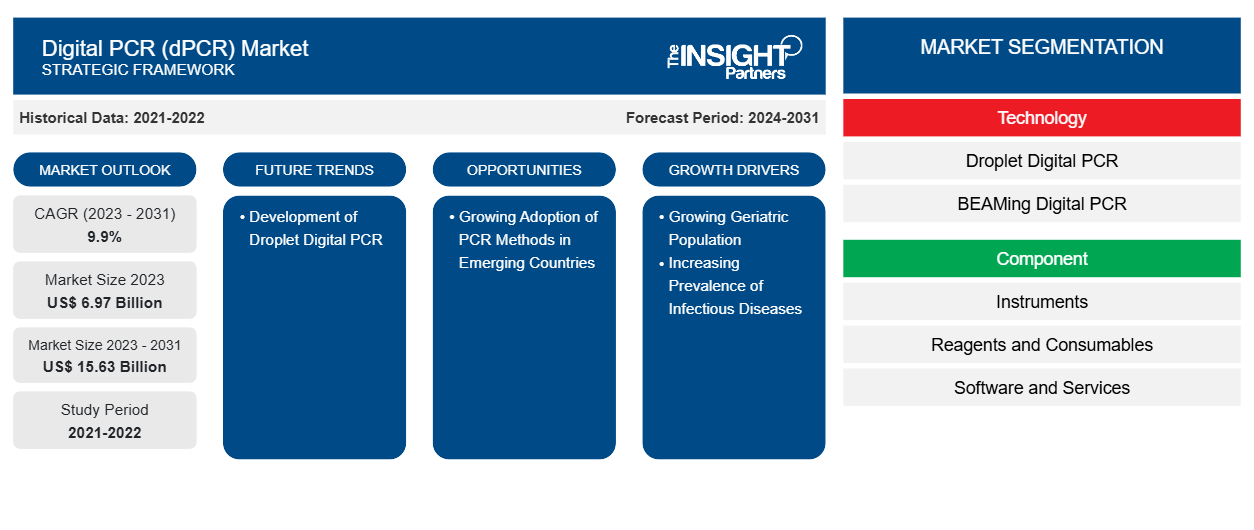디지털 PCR(dPCR) 시장 규모는 2023년 69억 7천만 달러에서 2031년 156억 3천만 달러로 성장할 것으로 예상되며, 이 시장은 2023년부터 2031년까지 9.9%의 CAGR을 기록할 것으로 추산됩니다.
dPCR은 초고감도 및 절대 핵산 정량화를 제공하는 획기적인 기술입니다. 특정 핵산 서열을 검출하는 데 가장 정확하고 정밀하며 민감한 기술 중 하나입니다. 분자 분석을 위한 중요하고 신뢰할 수 있는 도구가 되었습니다. dPCR 기술을 사용하여 이중 진단 및 치료할 수 있는 유전 및 감염성 질환의 증가는 디지털 PCR(dPCR) 시장 의 성장을 뒷받침합니다 . 디지털 PCR(dPCR) 시장 동향에는 표적 DNA 분자의 고정밀 및 절대 정량화를 지원하는 기술적 발전이 포함되어 진단 및 연구에서 광범위한 응용 프로그램을 가능하게 합니다.
성장 동인:
유전자 합성은 재조합 DNA 기술 분야에서 가장 널리 받아들여지는 도구입니다. 유전자 합성에서 재조합 단백질 발현 및 dPCR 기술은 증폭 및 정량화 목적으로 사용됩니다. 2021년, 생명공학 및 제약 산업에 유전자를 공급하는 합성 생물학 스타트업인 Camena Bioscience는 Mercia가 이끄는 1,000만 달러 규모의 시리즈 A 펀딩 라운드를 완료했습니다. 이 회사는 추가 자금으로 운영을 확장하고 획기적인 DNA 합성 플랫폼인 gSynth를 개발하는 데 박차를 가할 계획입니다. 이 기술 플랫폼과 기타 관련 리소스는 이 회사가 유전자 합성 개발을 가속화하는 데 도움이 됩니다.
2020년, 고성능, 신속하고 확장 가능한 유전자 합성을 위한 데스크톱 플랫폼을 만드는 합성 생물학 스타트업 EVONETIX LTD가 시리즈 B 자금 조달 라운드를 완료했다고 발표했습니다. Foresite Capital(신규 투자자)이 이끄는 이 회사는 이번 라운드에서 3,000만 달러(2,300만 파운드)를 모금했습니다. 따라서 기업의 투자 증가는 유전자 합성 시장 성장을 촉진하여 디지털 PCR(dPCR) 시장 성장에 기여합니다.
귀하의 요구 사항에 맞게 이 보고서를 사용자 정의하세요
이 보고서의 일부 또는 국가 수준 분석, Excel 데이터 팩을 포함하여 모든 보고서에 대한 사용자 정의를 무료로 받을 수 있으며 신생 기업 및 대학을 위한 훌륭한 혜택과 할인 혜택을 이용할 수 있습니다.
-
이 보고서의 주요 시장 동향을 알아보세요.이 무료 샘플에는 시장 동향부터 추정 및 예측까지 다양한 데이터 분석이 포함됩니다.
보고서 세분화 및 범위:
디지털 PCR(dPCR) 시장 분석은 기술, 구성 요소, 응용 프로그램, 최종 사용자 및 지리라는 세그먼트를 고려하여 수행되었습니다. 기술을 기준으로 시장은 드롭릿 디지털 PCR(ddPCR)과 BEAMing 디지털 PCR로 세분화됩니다. 구성 요소 측면에서 시장은 기기, 시약 및 소모품, 소프트웨어 및 서비스로 분류됩니다. 응용 프로그램을 기준으로 시장은 임상, 연구 및 법의학으로 분류됩니다. 디지털 PCR(dPCR) 시장 보고서의 지리적 범위는 북미(미국, 캐나다 및 멕시코), 유럽(프랑스, 독일, 영국, 스페인, 이탈리아 및 기타 유럽), 아시아 태평양(중국, 일본, 인도, 한국, 호주 및 기타 아시아 태평양), 중동 및 아프리카(사우디 아라비아, 남아프리카, UAE 및 기타 중동 및 아프리카), 남중미(브라질, 아르헨티나 및 기타 남중미)를 포함합니다.
세그먼트 분석:
제품별로 디지털 PCR(dPCR) 시장은 드롭릿 디지털 PCR(ddPCR)과 BEAMing 디지털 PCR로 분류됩니다. ddPCR 세그먼트는 2023년에 상당한 시장 점유율을 차지했습니다. 2023~2031년 동안 시장에서 가장 높은 CAGR을 기록할 것으로 예상됩니다.
구성 요소를 기준으로 시장은 기기, 시약 및 소모품, 소프트웨어 및 서비스 지표로 분류됩니다. 시약 및 소모품 부문은 2023년에 상당한 시장 점유율을 차지했으며 2023~2031년 동안 가장 높은 CAGR을 기록할 것으로 추정됩니다.
응용 프로그램을 기준으로 시장은 임상, 연구 및 법의학으로 세분화됩니다. 임상 부문은 2023년에 상당한 디지털 PCR(dPCR) 시장 점유율을 차지했으며, 2023~2031년 동안 가장 높은 CAGR을 기록할 것으로 예상됩니다.
최종 사용자를 기준으로 시장은 병원 및 진단 센터, 제약 및 바이오 기술 회사, 연구 실험실 및 학술 기관, 법의학 실험실, 임상 연구 기관으로 세분화됩니다. 병원 및 진단 센터 부문은 2023년에 상당한 디지털 PCR(dPCR) 시장 점유율을 차지했으며, 2023~2031년 동안 가장 높은 CAGR을 기록할 것으로 예상됩니다.
지역 분석:
지리적 측면에서 디지털 PCR(dPCR) 시장은 북미, 유럽, 아시아 태평양, 남미 및 중미, 중동 및 아프리카로 세분화됩니다. 2023년에 북미는 시장의 상당 부분을 차지했습니다. 2023년에 미국은 이 지역 시장을 지배했습니다. 북미의 디지털 PCR(dPCR) 시장 성장은 미국과 캐나다에서 진행된 과학 컨퍼런스, 워크숍 및 이벤트에 기인하며, 이를 통해 세계 여러 지역의 참가자들이 PCR에 기반한 트렌드와 최신 연구 결과를 교환할 수 있습니다. 예를 들어, Global Information Incorporation의 Global Engage는 전 세계 과학자들의 dPCR 전략 및 개발에 대한 기여를 특징으로 하는 이틀간의 정상 회담을 진행했으며, 의료 분야에서 dPCR의 기여와 관련된 사례 연구를 논의했습니다. 국가의 적극적인 참여는 또한 이 지역의 글로벌 디지털 PCR(dPCR) 시장에서 이 지역의 성장을 이끄는 원동력 중 하나입니다.
산업 발전 및 미래 기회:
디지털 PCR(dPCR) 시장 보고서에는 시장에서 경쟁사의 성과를 평가하기 위한 회사 포지셔닝과 집중이 포함됩니다. 회사 보도 자료에 따르면, 시장에서 활동하는 주요 업체가 취한 몇 가지 이니셔티브는 다음과 같습니다.
- 2023년 7월, Bio-Rad Laboratories, Inc.는 최초의 초고감도 멀티플렉스 dPCR 검사법인 ddPLEX ESR1 돌연변이 검출 키트를 출시했습니다. 이 제품을 출시하면서 회사는 고감도 멀티플렉스 돌연변이 검출 검사법이 전환 연구, 치료법 선택 및 질병 모니터링을 지원하는 종양학 시장에서 ddPCR 제공의 가용성을 확대할 계획입니다.
- 2021년 6월, Bio-Rad Laboratories Inc.는 지역 사회 폐수에서 SARS-CoV-2를 검출하기 위한 민감하고 비용 효율적이며 정확한 장비인 "Prevalence ddPCR SARS-CoV-2 Wastewater Quantification Kit"를 출시했습니다.
- 질병통제예방센터(CDC)는 폐수 검사에 ddPCR 기술을 권장하고, 환경보호청(EPA)은 이 기술을 폐수 중 바이러스를 정량화하는 신뢰할 수 있는 방법으로 발표했습니다.
디지털 PCR(dPCR) 시장 지역 통찰력
Insight Partners의 분석가들은 예측 기간 동안 디지털 PCR(dPCR) 시장에 영향을 미치는 지역적 추세와 요인을 철저히 설명했습니다. 이 섹션에서는 북미, 유럽, 아시아 태평양, 중동 및 아프리카, 남미 및 중미의 디지털 PCR(dPCR) 시장 세그먼트와 지리에 대해서도 설명합니다.

- 디지털 PCR(dPCR) 시장을 위한 지역별 데이터 얻기
디지털 PCR(dPCR) 시장 보고서 범위
| 보고서 속성 | 세부 |
|---|---|
| 2023년 시장 규모 | 69억 7천만 달러 |
| 2031년까지 시장 규모 | 156억 3천만 달러 |
| 글로벌 CAGR (2023-2031) | 9.9% |
| 역사적 데이터 | 2021-2022 |
| 예측 기간 | 2024-2031 |
| 다루는 세그먼트 |
기술로
|
| 포함된 지역 및 국가 |
북아메리카
|
| 시장 선도 기업 및 주요 회사 프로필 |
|
디지털 PCR(dPCR) 시장 참여자 밀도: 비즈니스 역학에 미치는 영향 이해
디지털 PCR(dPCR) 시장은 소비자 선호도의 변화, 기술 발전, 제품의 이점에 대한 인식 증가와 같은 요인으로 인해 최종 사용자 수요가 증가함에 따라 빠르게 성장하고 있습니다. 수요가 증가함에 따라 기업은 제품을 확장하고, 소비자의 요구를 충족하기 위해 혁신하고, 새로운 트렌드를 활용하여 시장 성장을 더욱 촉진하고 있습니다.
시장 참여자 밀도는 특정 시장이나 산업 내에서 운영되는 회사나 기업의 분포를 말합니다. 주어진 시장 공간에 얼마나 많은 경쟁자(시장 참여자)가 존재하는지 그 규모나 전체 시장 가치에 비해 나타냅니다.
디지털 PCR(dPCR) 시장에서 운영되는 주요 회사는 다음과 같습니다.
- 써모 피셔 사이언티픽 주식회사
- F. 호프만-라 로슈 유한회사
- 퀴아젠
- 아카라바이오 주식회사
- 애질런트 테크놀로지스 주식회사
면책 조항 : 위에 나열된 회사는 어떤 특별한 순서에 따라 순위가 매겨지지 않았습니다.

- 디지털 PCR(dPCR) 시장 주요 기업 개요를 알아보세요
경쟁 환경 및 주요 회사:
디지털 PCR(dPCR) 시장 전망은 이해 관계자가 성장 전략을 계획하는 데 도움이 될 수 있습니다. Thermo Fisher Scientific, Inc.; F. Hoffmann-la Roche Ltd.; QIAGEN; Akara bio, Inc.; Agilent Technologies, Inc.; Biomerieux SA; Abbott Laboratories; Merck KgaA; Promega Corporation; BD는 시장에서 프로필링된 저명한 기업 중 일부입니다. 이러한 회사는 새로운 첨단 제품 출시, 기존 제품의 발전 및 전 세계적으로 증가하는 소비자 수요를 충족하기 위한 지리적 확장에 중점을 둡니다.
- 과거 분석(2년), 기준 연도, CAGR을 포함한 예측(7년)
- PEST 및 SWOT 분석
- 시장 규모 가치/거래량 - 글로벌, 지역, 국가
- 산업 및 경쟁 환경
- Excel 데이터세트
최근 보고서
사용 후기
구매 이유
- 정보에 기반한 의사 결정
- 시장 역학 이해
- 경쟁 분석
- 고객 인사이트
- 시장 예측
- 위험 완화
- 전략 기획
- 투자 타당성 분석
- 신흥 시장 파악
- 마케팅 전략 강화
- 운영 효율성 향상
- 규제 동향에 발맞춰 대응























 무료 샘플 받기 - 디지털 PCR(dPCR) 시장
무료 샘플 받기 - 디지털 PCR(dPCR) 시장